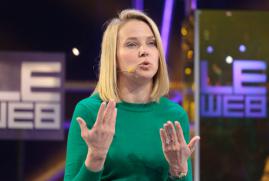 PARIS--There's been a lot of discussion of late about how Apple's iPhone remains the most profitable smartphone around, despite fierce competition from Android. That's relevant for companies like HTC and Samsung that sell Android phones. But Google has a different agenda with its freely available operating system: driving usage of its own services. That was the business interest that Google's Marissa Mayer discussed today at the LeWeb conference here. As the vice president in charge of products with a local component, she has a high interest in what happens on mobile phones. "Google Maps for Mobile shines more on Android because we can do so much more there," Mayer said. "Android is something special to us because we can do so much more in terms of features." Google makes its money from advertisements, including ads on maps. Ads can be made more relevant, at least theoretically, when they're delivered when people are at a place where they can actually buy what's being advertised. One example of how Android serves Google's ultimate goals is the move to vector-based mapping information, a much more compact way of storing the data than thousands of pixels of bitmaps. "Last year, we launched vectors in Maps. Maps became one thousandth the size," Mayer said. "Because the maps are smaller, they're a lot faster. That allowed us to introduce 3D buildings. Maps also caches maps...so even if your signal drops, you're still able to see the map around you." And last week, Google introduced Google Maps for Mobile 6.0, which brings the ability to navigate indoors in some malls, stores, and airports. The first phones to get the ability? Android. "These are innovations we're able to build inside Android because we have more freedom and flexibility there," Mayer said. The third-most used service on phones, after phone calls and text messages, is mapping, she said. In June, across all smartphones, mobile use of Google Maps permanently outpaced personal-computer use, she said. "On phones we've seen a huge growth in usage," she said. Local services dovetail with Google+, Google's social network service. Google+ "is really important to us, because local feeds social, and social feeds local," Mayer said. "Understanding connections between people, understanding where your friends have been, what your friends like--all those things are really important," and they're linked to location information, she said. Location data is built into Google+ mobile app, for example letting people see posts from people nearby and letting people tag their photos with geolocation information. But Google has a standalone app for sharing location information with friends, too, called Latitude. It may not have the profile of Google Maps or Gmail, but Mayer said Latitude is big. "We have more than 10 million users sharing their location through Latitude," Mayer said. "There is a lot of activity in local. there's a lot of potential, especially with the phone." | 








